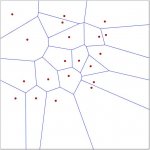Joel
0
- Messages
- 340
True 2D and 3D Voronois
Compared to my other wish list requests, this one is a long shot, but I hope Martin and C3D users will consider the creative applications of mathematically-calculated Voronoi 2D patterns and 3D designs.
C3D has a Voronoi material node which generates a wide range of procedural patterns, but it only imitates what some other graphics programs are doing in the fields of design, architecture and general scientific research.
Like 2D fractals, 2D Voronoi geometric patterns can be hand drawn, but it’s very slow and tedious. So Voronois remained obscure and unused until computers made it possible to create complex designs in real time. Like fractals, Voronoi patterns are ubiquitous in nature, and so provide a powerful starting point for creating new objects and architecture. Familiar examples are bubble clusters, foam, stress cracks, and plant and animal cells. Many real-life problems such as shortest-distance delivery routes and disease transmission can be visualized as voronoi cells. Voronoi structures have an inherent strength, economy, and integrity that make them ideal for anything from 3D printed knick-knacks to large buildings.
Very possibly, some of you are already using outside graphics programs to generate Voronois. If so, please advise forum readers about how to get started. Or advise Martin about potentially adapting or licensing available programs.
I lack the software to generate some pictures to illustrate the concept, so I will borrow a few simple examples from Open Sources and universities. As usual, Google.
http://learning.cis.upenn.edu/cis520_fall2009/index.php?n=Lectures.LocalLearning
voronoi.png
http://people.sc.fsu.edu/~jburkardt/f_src/sphere_voronoi/sphere_voronoi.html
http://people.sc.fsu.edu/~jburkardt/f_src/sphere_voronoi/gen_00100.png
http://www.qhull.org/html/qvoronoi.htm
normal_voronoi_knauss_oesterle.jpg
http://math.lbl.gov/voro++/about.html
cylinder_t.png
Compared to my other wish list requests, this one is a long shot, but I hope Martin and C3D users will consider the creative applications of mathematically-calculated Voronoi 2D patterns and 3D designs.
C3D has a Voronoi material node which generates a wide range of procedural patterns, but it only imitates what some other graphics programs are doing in the fields of design, architecture and general scientific research.
Like 2D fractals, 2D Voronoi geometric patterns can be hand drawn, but it’s very slow and tedious. So Voronois remained obscure and unused until computers made it possible to create complex designs in real time. Like fractals, Voronoi patterns are ubiquitous in nature, and so provide a powerful starting point for creating new objects and architecture. Familiar examples are bubble clusters, foam, stress cracks, and plant and animal cells. Many real-life problems such as shortest-distance delivery routes and disease transmission can be visualized as voronoi cells. Voronoi structures have an inherent strength, economy, and integrity that make them ideal for anything from 3D printed knick-knacks to large buildings.
Very possibly, some of you are already using outside graphics programs to generate Voronois. If so, please advise forum readers about how to get started. Or advise Martin about potentially adapting or licensing available programs.
I lack the software to generate some pictures to illustrate the concept, so I will borrow a few simple examples from Open Sources and universities. As usual, Google.
http://learning.cis.upenn.edu/cis520_fall2009/index.php?n=Lectures.LocalLearning
voronoi.png
http://people.sc.fsu.edu/~jburkardt/f_src/sphere_voronoi/sphere_voronoi.html
http://people.sc.fsu.edu/~jburkardt/f_src/sphere_voronoi/gen_00100.png
http://www.qhull.org/html/qvoronoi.htm
normal_voronoi_knauss_oesterle.jpg
http://math.lbl.gov/voro++/about.html
cylinder_t.png






